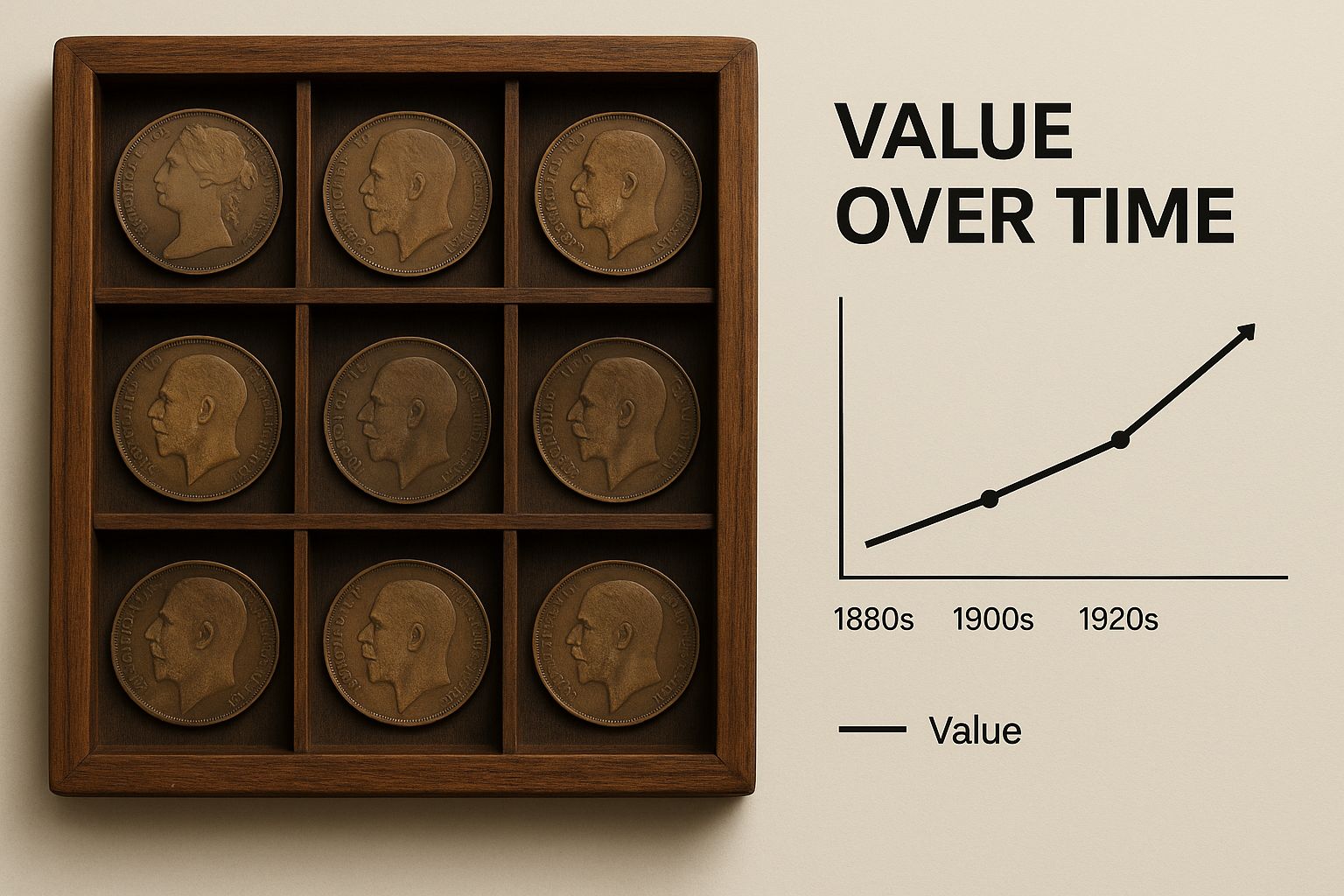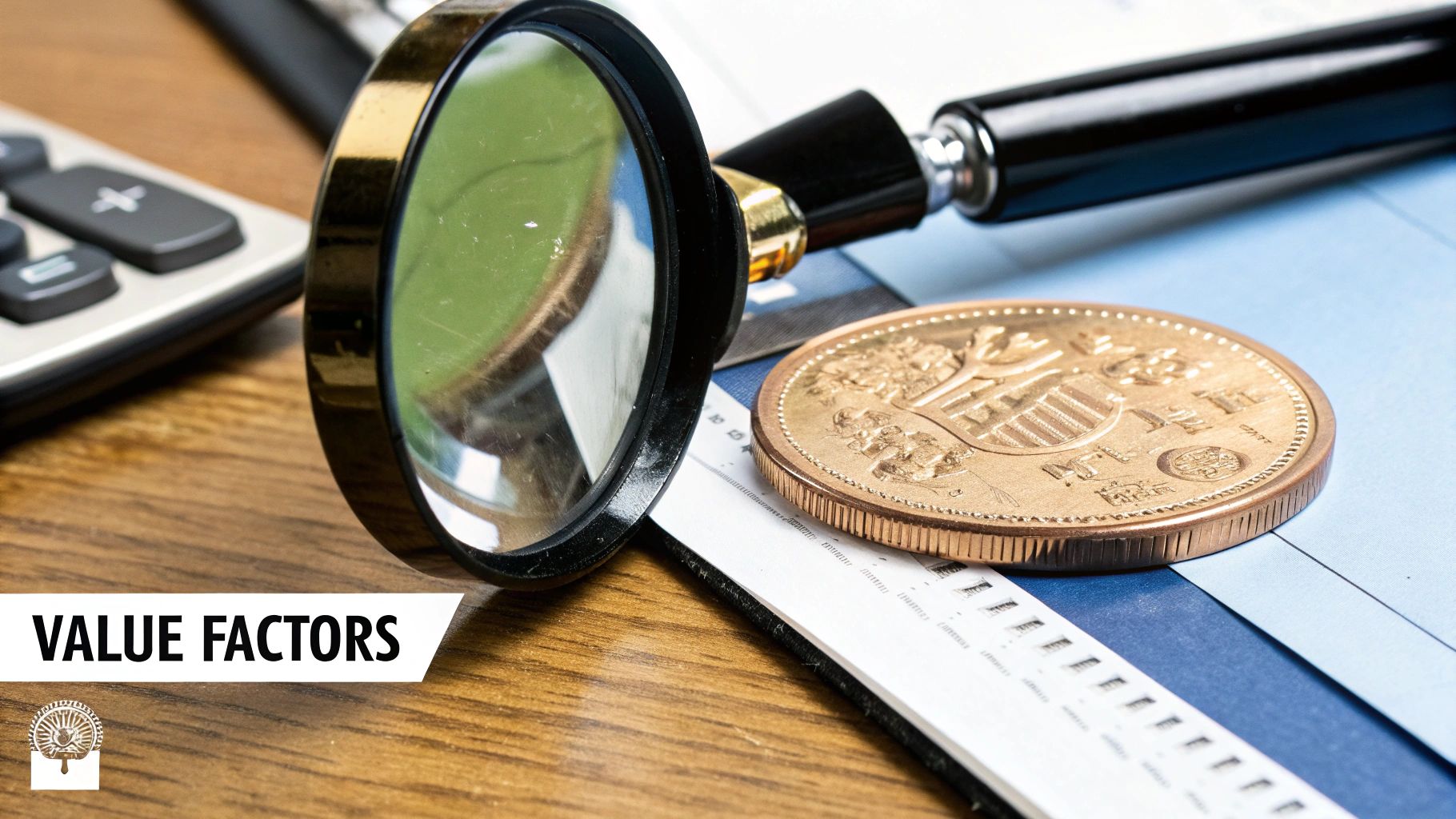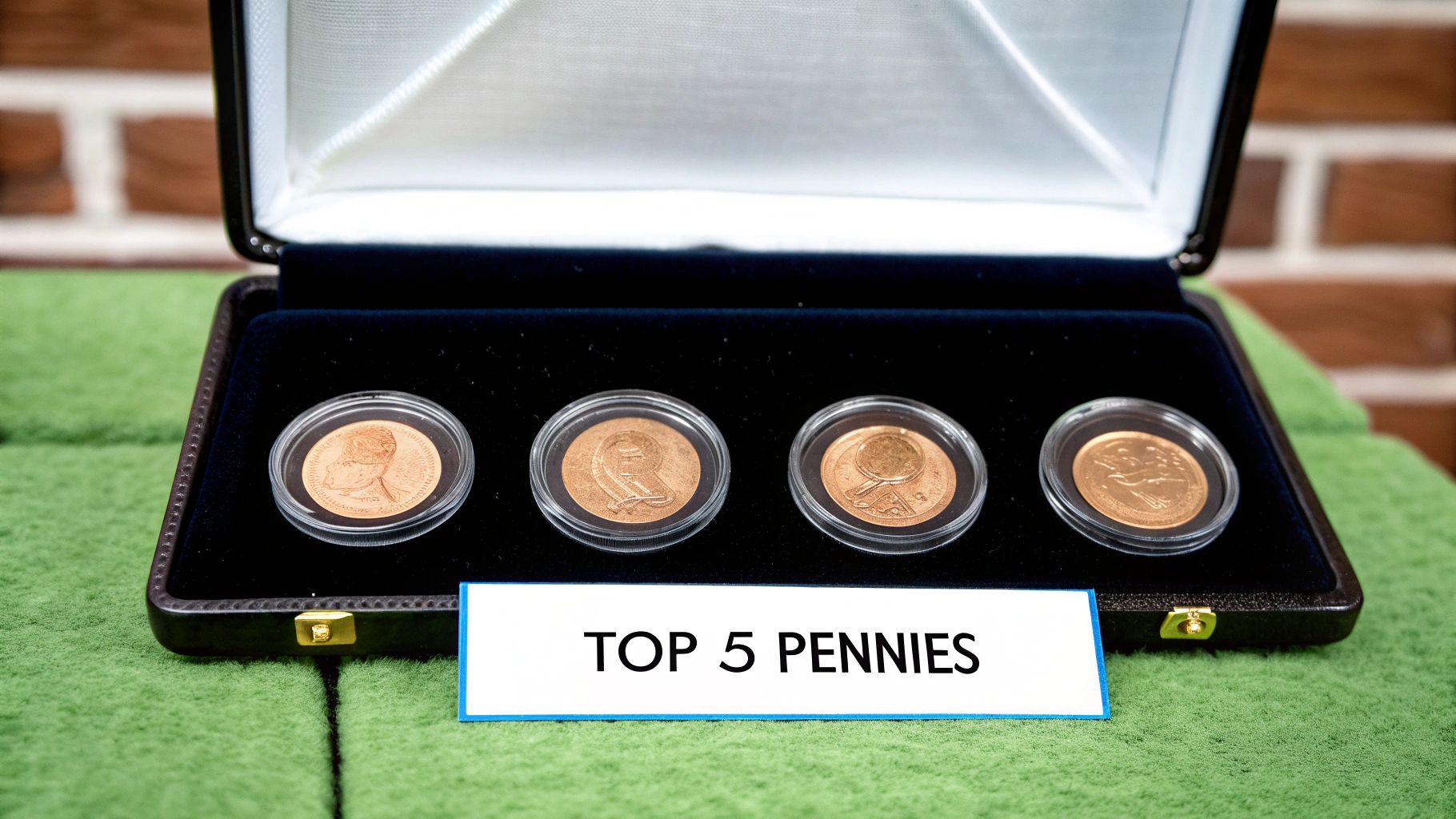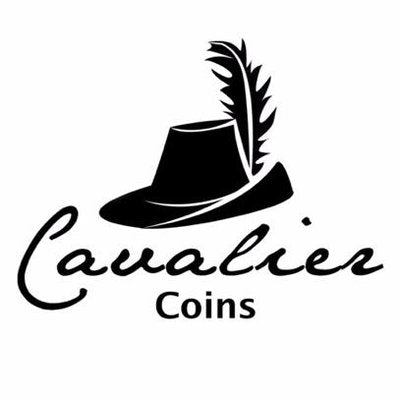Essential Guide To Old British Penny Values
Welcome to your definitive guide on old British penny values. This isn't just about the money – it’s about connecting with British history through these small, tangible pieces of the past. We'll explore the fascinating world of pre-decimal penny collecting, where history and condition come together to determine a coin’s worth.
You’ll discover why some pennies are worth hundreds, even thousands, of pounds, while others might only fetch a few. This guide will give you the tools to navigate this rewarding area of numismatics.
A Brief History of the Pre-Decimal Penny
Understanding the history of the British pre-decimal penny gives important context to collectors. Worth 1/240 of a pound or 1/12 of a shilling, the pre-decimal penny has a history spanning centuries. It was a vital part of the £sd (pounds, shillings, and pence) system used until Decimal Day in 1971.
The penny’s symbol, 'd', comes from the Roman denarius. Originally made of silver, it later changed to copper, then bronze. Discover more insights into the pre-decimal penny).
This screenshot from the Wikipedia page about the British pre-decimal penny summarizes its history and use. It highlights the penny's evolution through different metals and its important place in the pre-decimal monetary system, all contributing to its value today.
Key Factors Influencing Value
The shift to decimal currency in 1971 created unique opportunities for collectors. Pre-1971 pennies are tangible links to Britain’s past, increasing their appeal. This historical significance is a major factor driving their value.
Other key factors include:
- Mintage Figures: How many were made? Lower mintage often means higher value.
- Condition: A well-preserved penny is generally worth more.
- Rare Varieties: Certain variations and errors during production can make a penny highly sought after.
Understanding these elements helps you make smart choices when buying, selling, or simply appreciating these historical treasures. The following sections of this guide will dive deeper into each of these factors, providing a detailed understanding of old British penny values.
Complete Value Tables By Date and Condition
This guide provides essential information for valuing old British pennies. The tables below offer current market values, from medieval hammered pennies to 1971 issues. Organized by reign and date, they allow for quick lookups and informed collecting decisions.

This infographic provides a visual overview of how old British penny values can change over time. The image displays a collection of pennies, highlighting the general trend of increased value for older coins. Keep in mind that specific values depend heavily on factors like condition and rarity.
Victorian Bronze Penny Values (1860-1901)
The following table presents current market values for Victorian bronze pennies, showcasing the impact of condition on price. Remember, these values are representative and can change due to market fluctuations and the discovery of specific varieties.
For more details on evaluating coin condition, see the section on Professional Coin Grading Standards and Techniques.
Victorian Bronze Penny Values by Year and Grade
| Year | Good (£) | Fine (£) | Very Fine (£) | Extremely Fine (£) | Uncirculated (£) | Notable Varieties |
|---|---|---|---|---|---|---|
| 1860 | 0.50 | 1.50 | 3.00 | 5.00 | 10.00 | H Bun Head |
| 1870 | 0.30 | 1.00 | 2.00 | 3.50 | 7.00 | |
| 1880 | 0.20 | 0.75 | 1.50 | 2.50 | 5.00 | |
| 1890 | 0.15 | 0.50 | 1.00 | 1.75 | 3.50 | |
| 1900 | 0.10 | 0.30 | 0.60 | 1.00 | 2.00 | |
| 1901 | 0.75 | 2.50 | 5.00 | 8.00 | 15.00 | Low mintage |
As you can see, even within the same year, a penny's value can significantly increase with better condition. The 1901 low mintage penny, for example, jumps from £0.75 in Good condition to £15.00 in Uncirculated condition.
Edward VII Penny Values (1902-1910)
Following the Victorian era, Edward VII pennies offer further insight into old British penny values. This table similarly illustrates the influence of condition on value.
Edward VII Penny Values by Year and Grade
| Year | Good (£) | Fine (£) | Very Fine (£) | Extremely Fine (£) | Uncirculated (£) | Notable Varieties |
|---|---|---|---|---|---|---|
| 1902 | 0.20 | 0.70 | 1.40 | 2.40 | 4.50 | High relief |
| 1905 | 0.15 | 0.50 | 1.00 | 1.70 | 3.20 | |
| 1910 | 0.30 | 1.00 | 2.00 | 3.50 | 7.00 | Low mintage |
Similar to the Victorian pennies, the condition heavily influences the value. Always cross-reference these values with reputable resources and dealers for the most accurate and up-to-date information, as discussed in the Essential Resources and Quick Reference Tools section.

This screenshot from the NGC Coin price guide demonstrates a professional resource for old British penny values. It highlights the structured format these guides use, categorizing coins by type, date, and grade. Using trusted resources is key for accurate valuations. For more information about identifying valuable pennies and avoiding counterfeits, refer to our Identification Guide for Valuable Penny Varieties section. This will help ensure you can accurately assess old British penny values.
Rarity Factors That Determine Penny Values
Understanding what makes an old British penny valuable is more nuanced than simply considering its age. A combination of factors contributes to a coin's rarity and desirability, ultimately influencing its value. Mintage figures are a key starting point. Put simply, fewer coins minted means increased rarity, often translating to a higher value.
Take the 1933 penny, for example. With a mintage of just over 7 million, it's significantly rarer than the 1924 penny, which boasts a mintage exceeding 44 million. This difference in mintage directly impacts their respective values in the collector market.
Survival Rates and Historical Context
Beyond mintage, survival rates are crucial. Coins don't always survive the test of time. Wars, economic downturns, and even everyday wear and tear can drastically reduce the number of surviving coins. This scarcity, combined with historical context, significantly influences a coin's value.
Historically, the value of coins like the penny fluctuated greatly. In 1553, some coins increased in value to equal 15d (old pence), equivalent to 75p in decimal terms. By 1464, certain coins reached 100d, or about 41.67p decimally. The farthing, another pre-decimal coin, was worth 0.25d, while a penny was worth 1d, converting to 0.42p in decimal terms. These fluctuations reflect the complex economic and monetary shifts throughout British history. Discover more insights into pre-decimal British coin values. For further reading on rare pennies, check out this article: The Elusive Rarity: Exploring the Most Valuable British One Penny Coin.
Die Varieties, Errors, and Transitional Pieces
Beyond the basics of mintage and survival rates, factors like die varieties, mint errors, and transitional pieces can greatly increase a penny's value. Die varieties are subtle variations in the die used to strike the coin, creating unique features prized by collectors.
Mint errors, such as off-centre strikes or doubled dies, are unintentional production flaws that are highly sought after by numismatists. Transitional pieces occur during periods of design or metal composition changes, representing a specific and often brief moment in numismatic history.
Impact of Historical Events
Major historical events can also impact a penny's value. Periods of war or economic hardship often led to lower mintages or changes in metal composition, creating rare and valuable coins. World War II, for example, saw the penny's composition shift from bronze to steel due to metal shortages. These "war pennies" are now sought-after collectibles.
The interplay of these factors separates genuinely rare pennies from simply old ones. They add layers of interest and value to these small but significant pieces of British history. Identifying these rare pennies and understanding their value drivers is key for any collector.
Professional Coin Grading Standards and Techniques
Accurately grading old British pennies is key to understanding their value. This process involves carefully examining the coin for wear, surface condition, and overall appeal. Professional grading uses standard terms recognized by numismatists worldwide. By learning these standards, you can confidently evaluate your coins and understand descriptions from dealers or auction houses.
Understanding Wear and Damage
It's essential to differentiate between wear from circulation and damage from the environment. Circulation wear is the gradual smoothing of the highest points of the design, often starting with the monarch's hair or beard on older pennies. Environmental damage can appear as corrosion (green or brown deposits), scratches, or dings from mishandling. Improper cleaning, like harsh scrubbing or polishing, drastically reduces a penny's value. For a deeper dive into UK coin grading, check out our expert guide.
Recognizing Grade Levels
Professional coin grading uses a numerical scale, typically from 1 (Poor) to 70 (Mint State). Each grade reflects a specific level of preservation, with even small differences impacting value. An 1860 penny in Fine (F-12) condition might be worth a few pounds, while an Uncirculated (MS-65) example could be significantly more valuable. This highlights the importance of accurate grading.
Essential Grading Techniques
Effective grading requires the right techniques. Good lighting, ideally natural daylight or a specialized lamp, is crucial for seeing fine details. Magnification allows you to examine the coin closely, revealing tiny wear patterns and imperfections. A systematic approach, starting with a general impression and then focusing on specific areas like the rim, lettering, and central design, ensures consistent and accurate results.

British Coin Grading Standards
The table below outlines the key features of common grade levels. It provides a quick reference for understanding the relationship between grade, characteristics, and potential value multipliers.
British Coin Grading Standards and Characteristics Detailed breakdown of grading standards from Poor to Mint State with identifying characteristics
| Grade | Abbreviation | Key Characteristics | Typical Value Multiplier |
|---|---|---|---|
| Poor | P-1 | Barely identifiable design, heavy wear | 0.1x - 0.2x |
| Good | G-4 | Worn, but major design elements visible | 0.3x - 0.5x |
| Very Good | VG-8 | Moderate wear, some detail remaining | 0.7x - 1.0x |
| Fine | F-12 | Well-worn, but all design elements clear | 1.5x - 2.5x |
| Very Fine | VF-20 | Light wear, most details sharp | 3x - 5x |
| Extremely Fine | EF-40 | Minimal wear, nearly full detail | 7x - 10x |
| About Uncirculated | AU-50 | Traces of wear on high points | 12x - 20x |
| Uncirculated | MS-60 to MS-70 | No wear from circulation, possible mint imperfections | 25x+ |
These multipliers are estimates and can change depending on the specific coin and market conditions. They illustrate how grade significantly impacts the value of old British pennies. Learning these standards takes practice, but the result is a deeper understanding of numismatics and a more accurate assessment of your collection's worth.
Identification Guide For Valuable Penny Varieties
Developing a keen eye for valuable penny varieties is crucial for any collector. This guide provides the skills you need to spot those hidden treasures and avoid costly mistakes. We'll explore key diagnostic features—from die varieties and mint marks to design quirks and striking errors—that distinguish common pennies from their more valuable counterparts.
Essential Tools and Techniques
Identifying valuable pennies doesn't require expensive equipment. A 10x magnification magnifying glass is essential for observing subtle details. Proper lighting, like natural daylight or a bright lamp, is also important for revealing key features.
Examine pennies systematically. Start with a general overview and then focus on specific areas:
-
Rim: Inspect for imperfections or irregularities such as die breaks.
-
Lettering: Check for doubled dies or re-engraved dates.
-
Central Design: Examine the portrait or other main design elements for anomalies.
Key Variety Types to Look For
Understanding the variety types that increase a penny's value is essential. Key categories include:
-
Doubled Dies: These occur when the die strikes multiple times, creating a slightly blurred or doubled image.
-
Re-Engraved Dates: A re-engraved date on a die results in a subtly different appearance.
-
Die Breaks: These appear as raised lines on the coin, caused by cracks or breaks in the die.
-
Mint Errors: These are unintentional flaws like off-centre or broadstrikes.
-
Overdates: These occur when a new date is punched over an old one, often leaving remnants of the underlying date visible.
For accurate attribution, understanding specific diagnostic features for individual years and reigns within each category is crucial. Refer to standard catalogues like Spink for detailed information and images.
Common Mistakes to Avoid
Avoid these common pitfalls when identifying valuable penny varieties:
-
Mistaking Damage for Varieties: Scratches, corrosion, and other damage can mimic genuine varieties. Careful examination is crucial.
-
Overlooking Subtle Differences: Some valuable varieties have very subtle differences. Use magnification and pay close attention to detail.
-
Relying on Poor Quality Images: When researching online, use high-quality images for comparison.
Visual Guides and Catalogues
Visual guides and catalogues, like those from Seaby, are invaluable resources. They provide detailed images, descriptions, and estimated market values for valuable penny varieties. Cross-referencing your findings with standard catalogue listings ensures accurate identification and provides informed value estimates.
Practical Examples
Here are examples illustrating these identification principles:
-
1933 Penny: A "rotated die" variety exists where the reverse design is slightly rotated. Examine the alignment of design elements.
-
1860 Penny: The "H Bun Head" variety is identified by the specific shape of Queen Victoria's hair bun, often requiring magnification.
By learning these techniques and using reliable resources, you can develop the expertise to identify valuable penny varieties and avoid mistakes. Patience and careful observation are essential in this pursuit.
Record-Breaking Penny Sales and Market Leaders

The world of old British penny values is full of surprises. While many focus on common circulation finds, some pennies achieve legendary status, commanding impressive prices at auction. These record-breaking sales offer a glimpse into the high-end market, shaped by rarity, historical significance, and strong collector interest.
Legendary Rarities and Famous Collections
Certain British pennies stand out as truly exceptional. Medieval hammered silver pennies, often depicting early English monarchs, can reach thousands of pounds due to their age and historical importance.
Similarly, Victorian pattern pieces, trial designs never released into circulation, become highly sought-after for their scarcity and unique insight into numismatic development.
The provenance of a coin, especially from a well-regarded collection, can significantly boost its value. When famous collections are auctioned, the associated prestige adds a premium to these already valuable coins.
Market Trends and Investment Potential
Analyzing past sales and long-term price patterns reveals important trends. Condition rarity, as previously discussed, is a major factor. Even a slight difference in grade can dramatically affect a penny's price.
Historical context also plays a crucial role. Pennies connected to significant historical events or featuring rare die varieties become prime targets for serious collectors and numismatic investors.
The investment potential of these high-end pennies is clear, attracting those interested in tangible assets with historical and cultural significance. This interest extends beyond pre-decimal currency. The decimal penny, introduced in 1971, also has its own story.
By 2016, approximately 10.5 billion 1p coins were in circulation, with a face value of about £105 million. Originally made of bronze, the penny switched to copper-plated steel in 1992 due to rising copper prices. Its legal tender limit is 20p. Learn more about the decimal penny).
Future Market Directions
High-profile penny sales offer valuable insights into future market trends. Tracking the performance of key investment-grade pieces helps identify developing patterns and understand the dynamics of the top tier of the penny market.
Analyzing market data and understanding collector demand provides answers to crucial questions. Are certain periods gaining popularity? Which varieties are becoming more desirable?
By grasping these market forces, collectors and investors can make strategic decisions, maximizing returns and building valuable collections that appreciate over time. The world of old British penny values is a compelling intersection of history, numismatics, and investment, sparking continued interest and study.
Essential Resources and Quick Reference Tools
Building a successful old British penny collection takes more than just knowing their value. It requires continuous learning, reliable resources, and a network of trusted experts. This section equips you with the tools you need for a rewarding collecting journey.
Standard Reference Books and Online Databases
Reference books are crucial for accurate identification and valuation. Key publications include the Seaby Coin and Banknote Catalogue and the Spink Standard Catalogue of British Coins. These offer detailed information on dates, mint marks, varieties, and values.
Online databases, such as NGC Coin, provide up-to-date market data, images, and details on various penny types and grades. Cross-referencing information from multiple sources is always recommended.
For more helpful tips, see Seven tips for buying collectable coins.
Collector Organizations and Specialized Auction Houses
Joining collector organizations, like the British Numismatic Society or local coin clubs, connects you with a community of experts. These groups offer networking opportunities, educational seminars, and access to experienced collectors.
Specialized auction houses with dedicated British coin departments are invaluable. They offer access to rare and valuable pennies, providing insight into market demand and pricing. Reputable auction houses also ensure authenticity and accurate grading, essential for high-value investments.
Practical Checklists and Strategies for Success
Developing checklists for buying and selling is vital. These lists should include authentication steps, condition assessments, and documentation requirements.
Effective strategies for keeping up with market changes are equally important. This includes subscribing to numismatic publications, monitoring online forums and auction results, and attending coin shows.
Warning Signs and Pitfalls to Avoid
Being aware of warning signs can prevent costly mistakes. Be cautious of unusually low prices for rare varieties, deals that seem too good to be true, and sellers without proper credentials.
Common pitfalls include misidentifying varieties, overgrading coins, and neglecting to research market values before transactions. Careful examination, due diligence, and a cautious approach are key.
Ongoing Professional Support and Reliable Information Sources
Building relationships with trusted dealers and professional numismatists provides invaluable support. Experienced professionals can offer expert advice, authentication services, and appraisals.
Maintaining a list of reliable information sources ensures you have access to accurate and up-to-date market data. This includes reputable online resources, auction house catalogues, and publications on British numismatics.
Using these resources and tools will help you navigate the world of old British penny collecting and build a collection of historical significance and lasting value. Discover your next treasure at Cavalier Coins Ltd., your source for rare and unusual coins and banknotes from around the world.

